
Claytonia perfoliata, also known as miner's lettuce, Indian lettuce, spring beauty, winter purslane, or palsingat, is a flowering plant in the family Montiaceae. It is a fleshy, herbaceous, annual plant native to the western mountain and coastal regions of North America, from southernmost Alaska and central British Columbia, all the way south to Central America, but most common in California in the Sacramento and northern San Joaquin Valleys.

Claytonia virginica, the Virginia springbeauty, eastern spring beauty, grass-flower or fairy spud, is an herbaceous perennial in the family Montiaceae. Its native range is eastern North America. Its scientific name honors Colonial Virginia botanist John Clayton (1694–1773).

Claytonia sibirica, the pink purslane, candy flower, Siberian spring beauty or Siberian miner's lettuce, is a flowering plant in the family Montiaceae, native to the Commander Islands of Siberia, and western North America from the Aleutian Islands and coastal Alaska south through the Queen Charlotte Islands, Vancouver Island, Cascade and Coast Ranges, to a southern limit in the Santa Cruz Mountains. Populations are also known from the Wallowa Mountains, Klamath Mountains, northern Idaho, and The Kootenai. A synonym is Montia sibirica. The plant was introduced into the United Kingdom by the 18th century, where it has become very widespread.
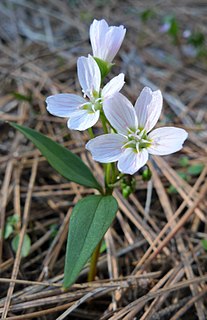
Claytonia lanceolata is a species of wildflower in the family Montiaceae, known by the common names lanceleaf springbeauty and western springbeauty.

Campanula griffinii is a species of bellflower known by the common name Griffin's bellflower. It is endemic to California, where it grows in the North and Central Coast Ranges in chaparral habitat on serpentine soils. This is an annual herb producing a thin, erect stem up to 20 centimeters tall. The leathery leaves are linear in shape, toothed along the edges, and less than a centimeter long. The stem and foliage are sometimes reddish in color and may have stiff hairs. The small, cylindrical flower is pale blue to white and less than 4 millimeters long. The fruit is an oblong, ribbed capsule.
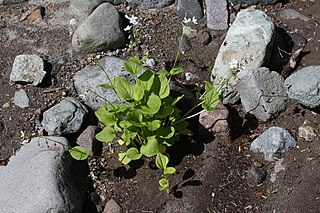
Claytonia cordifolia is a species of wildflower in the family Montiaceae known by the common name heartleaf springbeauty. It is native to western North America from British Columbia to Utah, where it grows in shallow lakes and in streams or springs and wetlands including bogs and fens according to Miller and Chambers (2006). It is a perennial herb growing from a long, budding rhizome and producing an erect stem up to 40 centimeters tall. The basal leaves have oval blades up to 9 centimeters long with heart-shaped bases where they attach to their long petioles. There is also a pair of oval-shaped leaves at a midpoint on the stem. The stalked inflorescence bears up to 12 small flowers with five white petals each about a centimeter long.
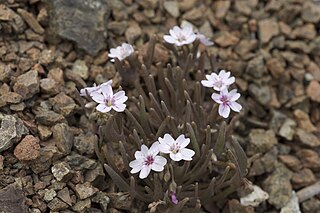
Claytonia gypsophiloides, known by the common names gypsum springbeauty and Coast Range claytonia, is a species of wildflower in the family Montiaceae.

Claytonia megarhiza is a species of wildflower in the family Montiaceae known by the common names fell-fields claytonia and alpine springbeauty. It is native to western North America from northwestern Canada to New Mexico, where it grows in rock crevices and talus habitats in subalpine and alpine climates. The species is known from summits and slopes of North America's highest mountains including the Redstone Mountains of the Canadian Northwest Territories, disjunct south to the central and southern Rocky Mountains reaching a southern limit in the Sangre de Cristo Mountains. The specific epithet megarhiza is Greek for "large roots".
Claytonia nevadensis, known by the common names Sierra springbeauty and Sierra Nevada claytonia, is a species of wildflower in the family Montiaceae. The evolutionary relationship of Claytonia nevadensis to other claytonias is a subject of debate and ongoing genetic studies. Sierra springbeauties are diploid with a chromosome base number of x = 7
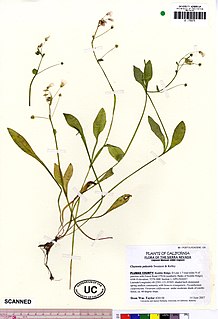
Claytonia palustris is a species of wildflower in the family Montiaceae known by the common names Jonesville springbeauty and marsh claytonia.
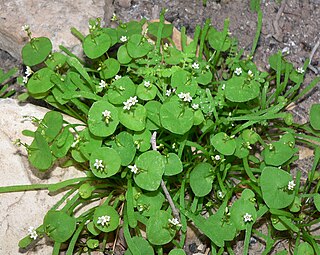
Claytonia parviflora is a species of wildflower in the family Montiaceae known by the common name Indian lettuce. It is native to western North America from southwestern Canada to northwestern Mexico, where it is found in many types of habitat, particularly areas that are moist in the spring. This is an annual herb growing in a clump or spreading to a maximum length of about 30 centimeters. The basal leaves are linear, often with an indistinct petiole. Some races may have lance-shaped blades on long, tapering petioles. There are also leaves on the flower stem which may be similar in shape or may be rounded or squared and sometimes fuse together to create a bowl around the stem. The herbage is green to pink in color. The inflorescence is a cluster of up to 40 small flowers, each with petals a few millimeters long and white to pink-tinted, or deep pink in color. The largest flowers, up to 1 cm in diameter, are found in Claytonia parviflora subsp. grandiflora, which is a subspecies endemic to the foothills and lower slopes of the western Sierra Nevada of North America. Together with Claytonia perfoliata and Claytonia rubra, Claytonia parviflora comprises what is almost certainly a polyploid pillar complex

Claytonia rubra is a species of wildflower in the family Montiaceae known by the common names redstem springbeauty and erubescent miner's lettuce. It is native to western North America from southwestern Canada to the Transverse Range of California, U. S. A. (and east to the Black Hills of South Dakota, U. S. A., where it is found in coniferous forests and shrublands. This is an annual herb with stems up to about 15 centimeters long. Some individuals may overwinter as biennials. The basal leaves have small rounded to diamond-shaped blades on long, tapering petioles. There are also leaves on the stem which may be rounded or squared and sometimes fuse together to create a bowl around the stem. All the leaves possess blunt tips according to published descriptions and taxonomic treatments. The herbage is red or pink in color at all stages of development. The inflorescence is a dense cluster of up to 30 tiny flowers, each with petals less than 4 millimeters long and white to pink-tinted in color. Together with Claytonia perfoliata and Claytonia parviflora, Claytonia rubra comprises what is almost certainly a polyploid pillar complex based on three diploid species, each occupying a definitive ecological niche
Claytonia saxosa, known by the common name Brandegee's springbeauty, is a species of wildflower in the family Montiaceae.
Claytonia umbellata is a species of wildflower in the purslane family known by the common name Great Basin springbeauty. It is native to the Great Basin of the United States, where it grows mainly in subalpine coniferous forests, often on north-facing exposed slopes in the talus. It is a perennial herb growing from a tuberous root up to 5 centimeters wide and a thin taproot. Most of the stem develops underground, as do the petioles of the most basal leaves. Above the ground appear a few oval-shaped fleshy red to green leaves and an inflorescence of up to 12 flowers. Each flower has five magenta to deeply pink-tinted white petals.
Epilobium halleanum is a species of flowering plant in the evening primrose family known by the common name glandular willowherb. It is native to parts of western North America from British Columbia to New Mexico, where it grows in many types of habitat. It is an erect perennial herb growing up to about half a meter tall. The leaves are oval in shape low on the stem and narrower and somewhat lance-shaped higher, the longest about 4.5 centimeters long. The inflorescence is a raceme of glandular flowers, each with four notched white to pink petals a few millimeters long. The fruit is an elongated capsule up to 6 centimeters long.
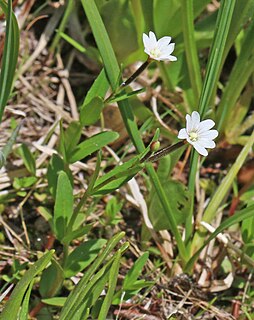
Epilobium oregonense is a species of flowering plant in the evening primrose family known by the common name Oregon willowherb. It is native to western North America from British Columbia to Arizona, where it generally grows in moist places in several types of habitat. It is a perennial herb growing spindly erect stems approaching 40 centimeters high or sometimes forming mats spreading via stolons. The small leaves are rounded near the base of the plant and linear in shape farther up the stem. The inflorescence bears flowers with four white to pink petals each a few millimeters long. The fruit is an elongated capsule up to 5 centimeters in length which is borne on a long pedicel which may be longer than the capsule itself.
Lessingia arachnoidea is a rare species of flowering plant in the daisy family known by the common name 'Crystal Springs lessingia'. It is endemic to California, where it is known from a few occurrences in the vicinity of Crystal Springs Reservoir on the San Francisco Peninsula and southward to serpentine soil in Woodside. It may also exist in Sonoma County to the north. The plant grows in chaparral, scrub, and other local plant communities, often on serpentine soils.
Smelowskia ovalis is a species of flowering plant in the mustard family known by the common name alpine false candytuft. It is native to western North America from British Columbia to northern California, occurring mostly in the Cascade Range. It is a plant of alpine climates, growing in high mountain habitat such as talus and fellfields. It is clumpy in shape, producing several hairy stems growing erect to a maximum height around 18 centimeters. The densely hairy leaves are divided into several oval leaflets. The longest leaves are arranged around the base of the plant, and a few smaller ones occur farther up the stems. The inflorescence is a dense, spherical raceme of flowers that elongates as the fruits develop. The flowers have white or pink-tinged petals each a few millimeters long. The fruit is a short silique.

Claytonia caroliniana, the Carolina springbeauty, is an herbaceous perennial in the family Montiaceae. It was formerly placed in the Portulacaceae. Its native range is eastern and central North America. It is most commonly found in the New England area of the United States but its habitat extends from Ontario and a northern limit in the Cape Anguille Mountains of Newfoundland and south to Alabama. It grows approximately 6 inches tall in forests of the Appalachian Mountains and piedmont
Claytonia tuberosa, commonly known as Beringian springbeauty, is a species of flowering plant in the family Montiaceae. It is a perennial herb indigenous to Alaska, British Columbia, Northwest Territories, and the Yukon of North America, westward to East Asia–Siberia. The perennial grows from a globose tuberous root to a height of 15 centimetres (6 in) and bears several hermaphrodite white flowers on stems bearing a single pair of petiolate cauline leaves. Probably its closest relative is Claytonia virginica.













